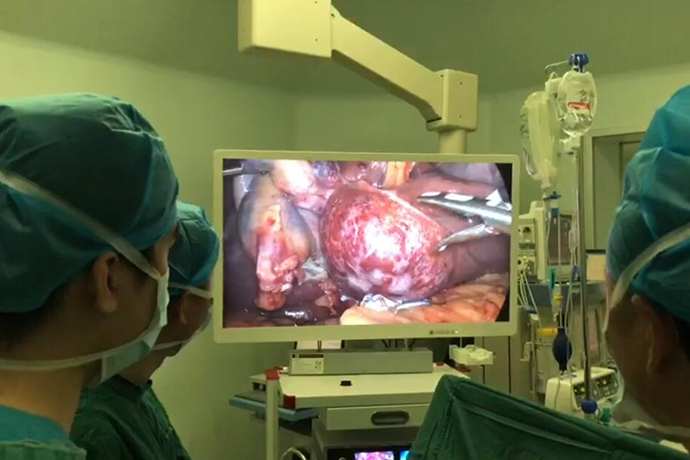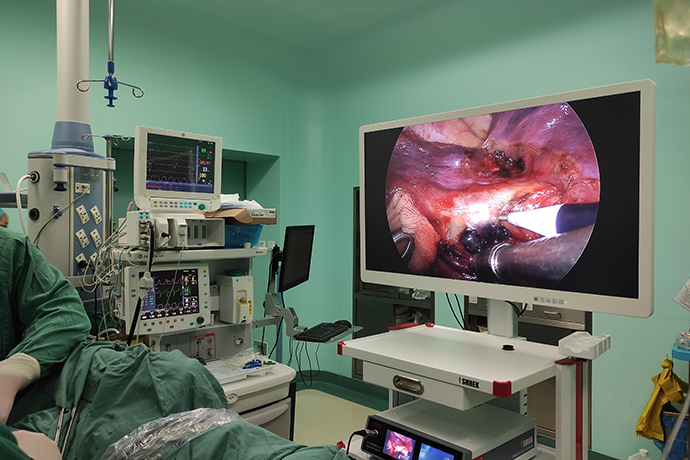[Thoracoscopic Surgery in Thoracic Surgery] 4K ultra-high definition thoracoscopic lung volume reduction surgery
Release time: 02 Jan 2024 Author:Shrek
Lung volume reduction surgery refers to a surgical method to treat emphysema by surgically removing non-functioning lung tissue that has been expanded and destroyed by over-inflation. It is called pneumonectomy or lung volume reduction plasty. Compared with traditional thoracic surgery, 4k thoracoscopic lung volume reduction surgery has the advantages of less trauma, less blood loss, faster recovery, and less pain. 4k thoracoscopic lung volume reduction surgery has changed traditional thoracic surgery. The surgery is invasive and recovery is slow. Most patients with severe emphysema are physically weak and have poor ability to tolerate surgical trauma.

Compared with the best medical treatment, lung volume reduction surgery (LVRS) can improve the quality of life of some patients with surgical indications and improve lung function, exercise tolerance, and long-term survival. Although lung volume reduction surgery can be performed by either VATS or midline thoracotomy, with similar complication rates, mortality, and outcomes, VATS recovery is faster and less expensive.
Lung volume reduction surgery is indicated in patients who remain symptomatic despite optimal medical treatment, including respiratory exercise therapy, oxygen therapy, and pulmonary rehabilitation, which can help screen and treat patients. Patients with severe emphysema are generally in poor condition and require lower limb rehabilitation exercises and relief of dyspnea. Patients in better condition are better prepared to cooperate with postoperative work, such as getting out of bed within a short period of time after surgery and using stimulation spirometers to reduce respiratory complications. Patients who do not cooperate well or who fail pulmonary rehabilitation are not candidates for lung volume reduction surgery. The most important selection factor for lung volume reduction surgery is the uneven distribution of emphysema on CT and lung perfusion imaging.
1. Methods of thoracoscopic lung volume reduction surgery
Surgical steps
Usually minimally invasive 4K ultra-high-definition thoracoscopic lung volume reduction surgery is a staged bilateral surgery with the patient in the lateral position. Unless there is severe air leakage on one side after surgery, the patient should be turned over to perform lung volume reduction surgery on the other side. The extent of resection depends on preoperative CT and lung perfusion imaging and is usually located in the upper lobes. This area often does not collapse during surgery due to poor elastic recoil.
Main points
1. Operate on the top of the lung from front to back.
2. Resection starts from the front segment of the upper lobe immediately adjacent to the upper edge of the middle lobe of the right lung or the lingual segment of the left lung.
3. Minor air leaks may take several weeks to heal. During the operation, the manipulation and contact with the lungs must be limited. The lungs of patients with severe emphysema are very soft. Even gently poking the lungs with a suture device may cause a breach in the lungs.
4. Reoperation to close the leak is rarely required.
1. Thoracoscopic lung volume reduction surgery
Step one: incision
1. Incision 1: Make a 2cm incision in the 6th intercostal space at the midclavicular line, as low as possible and as close to the middle as possible. This location is usually one intercostal space below the inframammary crease. The dissection is turned posteriorly (away from the pericardium) through this incision so that instruments passing through this incision are automatically directed posteriorly toward the oblique fissure rather than toward the heart. Insert your fingers through the incision to check for adhesions.
2. Incision 2: Make a 5mm incision in the 9th intercostal space at the midclavicular line and insert a 5mm trocar and a 30° thoracoscope.
3. Incision 3: Make a 2cm incision in the fourth intercostal space in the mid-axillary line.
Step Two: Decompression of the apical bulla
1. Exposure: Pull the upper lobe of the right lung toward the top of the pleura.
2. The thoracoscope points forward and the 30° lens points upward.
3. For poorly collapsed bullae at the apex of the lung, use an electric knife to enter through incision 3 and cut into the right upper lobe tissue to decompress the bulla tissue in the upper lobe.
Step Three: Lung Resection
1. Exposure: Pull the lower lobe of the right lung directly toward the top of the pleura.
2. The thoracoscope points forward and the 30° lens points upward.
3. As with all surgeries, exposure is key. Use oval forceps to lift the lung parenchyma through incision 3 and align it with the suture device inserted from incision 1.
4. The padding on the stapler helps reduce air leakage when stapling the lungs. Do not use force when placing the stapler, otherwise it may cause the lung to tear and cause air leakage. Be sure to align the lung tissue before placing the stapler so that the stapler can easily close the lung tissue.
5. If the lung tissue cannot be accurately aligned, the suture device will be inserted obliquely into the lung, causing a lung tear.
Step Four: Surgery completed
1. Exposure: Pull the lower lobe of the right lung directly toward the top of the pleura.
⒉The thoracoscope points forward and the 30° lens points to the top.
3. Continue to close the lung with a padded suture 3 to 4 cm from the lateral side of the horizontal and oblique fissures and close to the medial side of the hilum. After firing the stapler, move the oval forceps holding the lung tissue closer to the stapled lung tissue.
4. After the stapling is completed, cut the padding part that connects the specimen and the lungs.
Step 5: Remove the specimen
1. Exposure: Since enough lung tissue has been removed during lung volume reduction surgery to provide good exposure of the chest, there is no need to retract the lung tissue.
2. The thoracoscope points forward and the 30° lens points to the top.
3. Use oval forceps to remove the cut lung tissue from incision 1.
1. Postoperative care
(1) Remove the tracheal intubation in the operating room.
(2) Analgesic treatment is urgently needed and allows the patient to ambulate, cough, and use a stimulated spirometer. An epidural tube is inserted first and then anesthesia is given for analgesia. Patient-controlled analgesia can be used when epidural analgesia is not effective. Immediate pain relief after surgery is very important to prevent the occurrence of pneumonia.
(3) Respiratory care is very important.
Early activity in the hallway twice daily can reduce the incidence of pulmonary complications.
Actively carry out nebulization and lung physiotherapy. It is not necessary to apply negative pressure to the chest drainage tube.
If the chest drainage tube is in a low position and there is still air leakage in the drainage tube, a drainage tube with a Heimlich valve can be used. This device helps the patient ambulate.
Even if the patient has no carbon dioxide retention before surgery, the partial pressure of carbon dioxide often reaches about 60mmHg after lung volume reduction.
(4) About 20% of patients develop arrhythmia, especially atrial fibrillation. The cause is hypoxemia and atelectasis.
(5) Gastrointestinal complications are common. If the patient does not have a bowel movement within 2 days, laxatives may be used. Swallowed air, painkillers, and epidurals can all cause bloating or even colon perforation.

- Recommended news
- 【General Surgery Laparoscopy】Cholecystectomy
- Surgery Steps of Hysteroscopy for Intrauterine Adhesion
- [Gynecological Hysteroscopy] Techniques for Preventing and Treating Complications of Hysteroscopic Surgery
- [Gynecological Hysteroscopy] Hysteroscopic Adhesiolysis
- [Gynecological Hysteroscopy] IUD Removal under Hysteroscopy